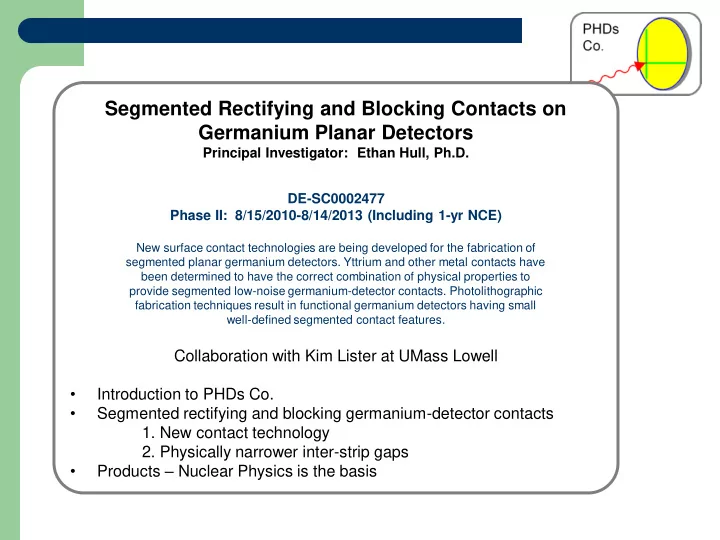

Segmented Rectifying and Blocking Contacts on Germanium Planar Detectors Principal Investigator: Ethan Hull, Ph.D. DE-SC0002477 Phase II: 8/15/2010-8/14/2013 (Including 1-yr NCE) New surface contact technologies are being developed for the fabrication of segmented planar germanium detectors. Yttrium and other metal contacts have been determined to have the correct combination of physical properties to provide segmented low-noise germanium-detector contacts. Photolithographic fabrication techniques result in functional germanium detectors having small well-defined segmented contact features. Collaboration with Kim Lister at UMass Lowell • Introduction to PHDs Co. • Segmented rectifying and blocking germanium-detector contacts 1. New contact technology 2. Physically narrower inter-strip gaps • Products – Nuclear Physics is the basis
PHDs Co. 3011 Amherst Rd, Knoxville, TN www.phdsco.com • Germanium Detector Systems • Concept • Germanium refinement and crystal growth • Mechanical-Vacuum-Cryogenic Engineering • Detector Fabrication • System Integration • Information output • Est. Fall 2004, Ethan Hull CEO, Richard Pehl CFO SPG • 9 FTEs + 2-3 Consultants – Technical Emphasis • PHDs Co. sells germanium detector system products • Nuclear Physics - NPX-M • Security Applications - GeGI and SPG • Nuclear Medicine - MIX
PHDs Co. 10,000 ft 2 Facility Knoxville, TN Technical area (~ 8000 ft 2 ) Office area (~ 2000 ft 2 )
Germanium detector fabrication facility
• Segmented rectifying and blocking germanium-detector contacts • New contact technology – Yttrium metal • Physically narrower inter-strip gaps Amorphous-germanium Yttrium contact 250 µm gaps contact 500 µm gaps
• New n+ (hole barrier) contact technology – Yttrium metal Historic dilemma: The surface (interface states) of crystalline HPGe is p type. Most materials form an electron barrier. Damage is p-type. Lithium thermal diffusion (~ 500+ μ m) forms a rugged hole-barrier contact for 99% of Ge detectors. Thick, cannot be segmented easily . Amorphous-germanium and Yttrium metal form this type of contact.
• New n+ (hole barrier) contact technology – Yttrium metal • Yttrium metal • Heterojunction, not Schottky barrier 𝑗 ~ 𝑓 − 𝜒 1.E-06 • Hole barrier height ϕ ~ 0.4 – 0.6 eV – higher than 𝑙𝑈 1.E-07 amorphous germanium but variable -- HJ 1.E-08 • Thin and segmented with photolithography • Published and Patent Pending 1.E-09 i (A) 1.E-10 120 K 1.E-11 1.E-12 1.E-13 1.E-14 1.E-15 0.006 0.007 0.008 0.009 0.01 0.011 0.012 0.013 1/T (K -1 )
100 µm 250 µm 500 µm gap gap gap • Photolithograph Narrower gaps • Less gap charge-collection problems • 1000 Must be amenable to fabricating a 57 Co working germanium detector 122 keV FWHM = 0.95 keV FWTM = 1.80 keV 137 Cs 100 662 keV FWHM = 1.32 keV FWTM = 2.61 keV 10 1 0 100 200 300 400 500 600 700
• Implications of narrower gaps for strip detectors Mechanically Cooled LN 2 Cooled NPX-M Systems NPX Systems Significant enabling leap forward
Implications of narrower gaps for strip detectors Complete NPX-M Germanium Strip Detector Systems for Nuclear Physics require only 120 VAC Amorphous-germanium contact 500 µm gaps 60 lbs Bench top system
2 Induced Charge 1 0 10 20 30 40 t (ns) Charge loss due to gap collection 1 2
122 keV FWHM = 1.2 keV Typical Individual pixel energy spectroscopy 662 keV FWHM = 2.0 keV
122 keV 662 keV FWHM ~ 1.4 keV FWHM ~ 2.2 keV Typical PIXEL-TOTAL Energy Spectroscopy (The sum of all detector pixels)
250 µm gaps (NP7 – UMass Lowell, Kim Lister, May 2012) 500 µm gaps 250 µm gaps (Previous NPX) (NP7)
500 µm gaps 1000000 100000 All events Pixel total 10000 (All events) 1000 _ (Pixel total) 100 0 20 40 60 80 100 120 140 160 E (keV) Compton = Photoelectric at E γ = 140 keV in Ge Substantial neighboring strip scattering Less gap charge loss 250 μ m gaps 10 % higher efficiency at 140 keV 1000000 More efficient Polarimeter for Nuclear Physics 100000 All events Pixel total 10000 (All events) 1000 _ More efficient detector for Nuclear Medicine (Pixel total) 100 0 20 40 60 80 100 120 140 160 E (keV)
Recommend
More recommend